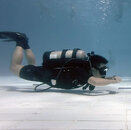topher10
Contributor
As a new diver, I have been working to improve trim and bouyancy control. I feel fairly confident in my ability to hold trim and depth, although with any task loading I can break trim and that is currently what I am working. For instance, staying fixed during a mask removal and replacement. The other issue is that if I become completely motionless I will slowly roll or break trim. Most recently I was slowly rolling to the left and back.
However, when I came back from my trip I started watching videos closely, and I notice that in almost all cases the diver is not completely motionless, but is slowly moving his/her fins back and forth. Often its small and just using the ankles, but there is a this more or less constant back and forth motion that helps maintain balance. I have watched GUE videos, ISE videos, random videos, etc.
So I have a few questions:
1. What is a realistic goal for holding trim/position with minimal movement? I assume no use of hands/arms, and very minor fin movements.
2. Is there a specific pattern or style for this small fin movement I see. In other words, is it specifically taught, or do divers just learn to do it unconsciously to maintain trim.
3. If one completely stops all movement, how long is a normal time before rolling/tilting occurs and trim breaks down.
However, when I came back from my trip I started watching videos closely, and I notice that in almost all cases the diver is not completely motionless, but is slowly moving his/her fins back and forth. Often its small and just using the ankles, but there is a this more or less constant back and forth motion that helps maintain balance. I have watched GUE videos, ISE videos, random videos, etc.
So I have a few questions:
1. What is a realistic goal for holding trim/position with minimal movement? I assume no use of hands/arms, and very minor fin movements.
2. Is there a specific pattern or style for this small fin movement I see. In other words, is it specifically taught, or do divers just learn to do it unconsciously to maintain trim.
3. If one completely stops all movement, how long is a normal time before rolling/tilting occurs and trim breaks down.





